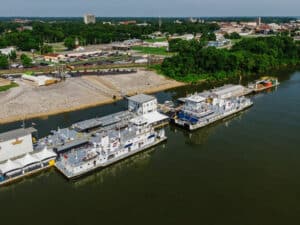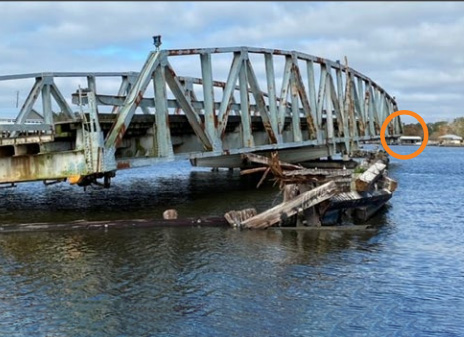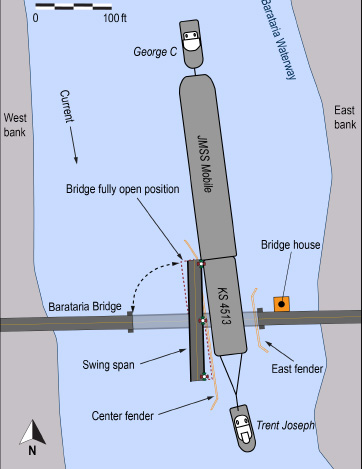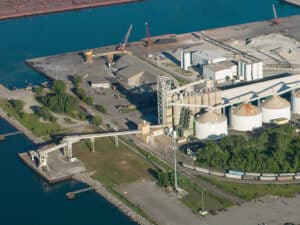
NTSB reports on $500,000 barge contact with Barataria Bridge
Written by Marine Log Staff
Postaccident damage to the Barataria Bridge looking north. The corner of the swing span that the barge contacted is circled.[Image: NTSB]
The National Transportation Safety Board (NTSB) has completed its investigation of a November 22, 2020, accident involving barges towed by the Trent Joseph and George C and the Barataria Bridge near Barataria, La. The bridge, which was the only means of road access for the community of Barataria, was damaged and remained unusable until November 28. There were no injuries and no pollution reported. Damage to the barge was negligible, while damage to the bridge was reported to be more than $500,000.
On the day of the incident, says the NTSB report, the 67-foot-long, 1,440-hp towing vessel Trent Joseph, owned by Coastal Towing LLC, and the the 68-foot-long, 1,000-hp George C, owned by Cvitanovic Towing LLC, were towing two barges southbound in the Barataria Waterway.
The Trent Joseph was towing two barges behind in a single string by means of a tow bridle and shock line extending an estimated 70–75 feet from the towboat’s stern to the forward barge. That barge, the KS 4513, measured 140 feet long and 45 feet wide, and had on its deck a cargo of concrete fish boxes for an artificial reef project.
The aft barge, JMSS Mobile, measured 264 feet long and 51 feet wide and carried an excavator crane and associated equipment. There was no deck cargo or equipment overhanging past the hull of either barge. The captain of the Trent Joseph stated that he wanted to place the larger and wider JMSS Mobile at the head of the tow with the narrower KS 4513 aft, but, because the head of the JMSS Mobile did not have any deck fittings to which the crew could secure the towing bridle, they had to place it at the back of the tow with its stern coupled to the stern of the KS 4513 and its rake facing aft.
George C
Behind the barges, connected by an estimated 10- to 15-foot tow line, was the George C, with a crew of four, operating as the tail boat. As the tail boat, the George C would act based on the instructions given by the operator of the lead boat, the Trent Joseph, to use its propulsion to keep the barges from running over the lead boat if it were to slow down or stop. As described by its captain, the George C acted as “the brakes” for the tow. Additionally, according to the captain of the Trent Joseph, the tail boat could also act to help move the tow to port and starboard as needed.

While passing through the open Barataria Bridge, the second barge contacted the bridge’s swing span. The damage to the bridge left it unusable until November 28.
Both the Barataria Bridge’s center and east fenders had red navigation lights to mark the ends and middle of each fender. The east fender’s red lights were removed for repair before the accident. The NTSB reports that the captain of the Trent Joseph stated that, as the tow approached the bridge, the two red lights marking the center fender that should have been visible to him were not.
He used a spotlight to look for the fenders when approaching the bridge. When the Trent Joseph was about 100 feet from the bridge, the captain saw with the spotlight that the swing span had “over-rotated” and extended past the center fender wall.
Louisiana Department of Transportation and Development maintenance records indicated that two days before the accident work had been conducted on the bridge’s limit switches (which prevent the movement of the swing span beyond a predetermined point).
Investigators determined the probable cause of the contact of the tow with the Barataria Bridge was a corner of the bridge’s swing span protruding outside of its protective fendering into the navigable channel after recently attempted repairs to the limit switch system that controlled the swing span’s rotation limit.
As always the full NTSB report gets into some interesting detail, including that the postaccident survey report documented that the bridge’s “entire” fender system contained previous damage and was “structurally unsuitable” for protecting the bridge as designed. The report also notes that According to Coast Guard records, from 2001 to the accident date there had been a total of nine incident investigations related to vessel contacts with the fendering system of the bridge.

![Tom Frazier aground and listing to starboard on Feb. 11, 2024. [Photo: U.S. Coast Guard]](https://www.marinelog.com/wp-content/uploads/2025/06/Towboataground-300x225.jpg)


